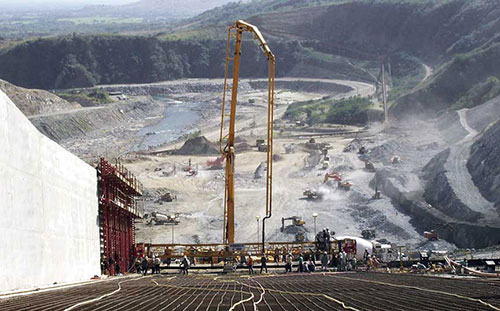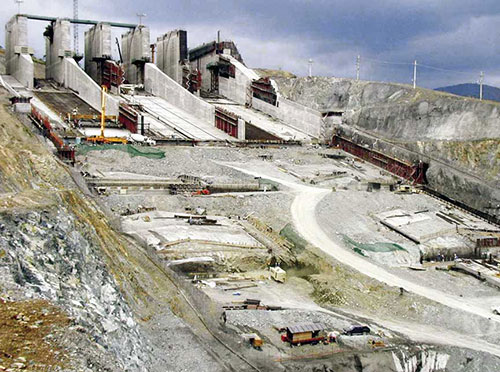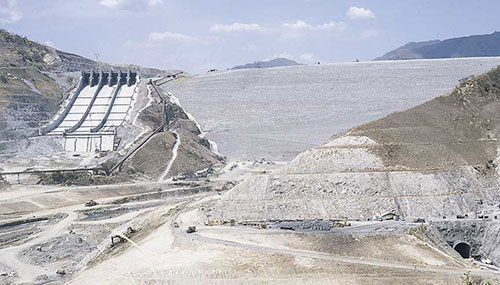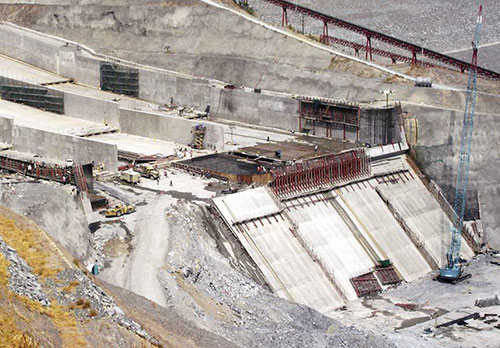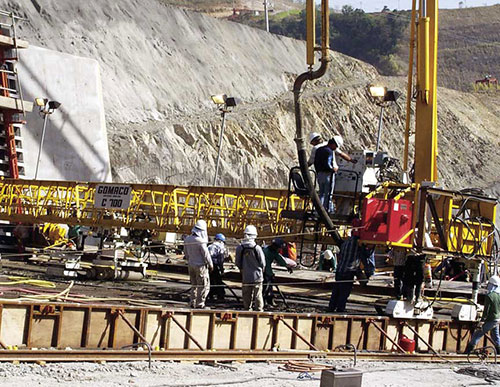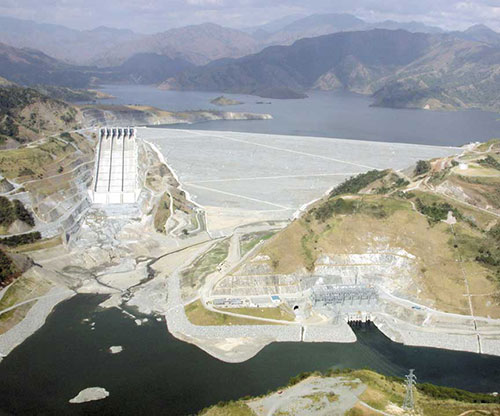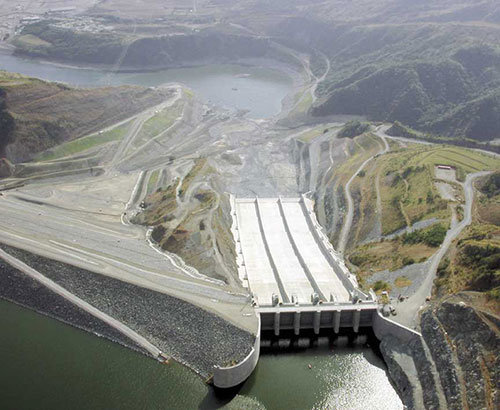GOMACO World Index --- GOMACO World 31.1 - March 2003
Finishing The Spillway On The World's 12th Highest Earthen Dam
The San Roque Multipurpose Project involved the construction of an embankment dam along the Agno River in the Luzon island province of Pangasinan, Philippines. The San Roque Dam has a height of 656 feet (200 m) and is 3707 feet (1130 m) in length. At those dimensions, it's the 12th highest earth/rock-fill dam in the entire world, with a reservoir capacity of 1.1 billion cubic yards (850 million m3). While at its peak, the San Roque Project was one of the largest on-going construction projects and employed over 5000 workers.
Raytheon Engineers and Constructors, a company that eventually merged with Morrison Knudsen to form Washington Group International, won the total design/build obligation from developer Sithe Energies, Inc. The huge responsibility of this massive undertaking was put into the hands of Raytheon project manager, Robert Resch.
According to Resch, "The risk of significant rainfall and runoff during the wet seasons suggested a long completion time, but with an effective plan and constant coordination, we were confident we could mitigate most scheduling problems.
"The San Roque Dam was a Philippine flagship project and our contract included both the design and building," Resch explained. "Beginning with our engineering in March 1998, the fast-track project was completed just 58 months later."
For the job of concrete finishing the dam's spillway, Raytheon turned to GOMACO Corporation to develop a machine that would meet their specifications. After extensive testing, the GOMACO C-700 Cylinder Finisher proved to be that machine. Outside the GOMACO factory in Ida Grove, Iowa, a special ramp was built to simulate the spillway inclines. Resch, along with other managers from Raytheon, came to Ida Grove to observe the C-700 operating and have meetings with the GOMACO design team to make sure the C-700 was equipped correctly and would produce the results required for the spillway. Upon completion of the tests in Ida Grove, the C-700 was delivered to the Philippines for further testing on site.
The spillway is located on the right-hand abutment of the dam and guides the flow of excess water supplied to the reservoir. At 328 feet (100 m) wide and 1722 feet (525 m) long, the San Roque Dam spillway is designed for a flow of 452,028 cubic feet (12,800 m3) per second.
Approximately 800 laborers worked around the clock, 24 hours a day, seven days a week, in two shifts to complete the spillway's four main sections: the ogee, spillway walls, spillway chute slabs, and the flip bucket.
The spillway is separated into three sections by two 26 feet (8 m) high longitudinal walls. Each section is 98 feet (30 m) wide and runs the entire length of the spillway, from the ogee at the top to the flip bucket at the bottom. The C-700 was set up to finish each slab within each section in two 49 feet (15 m) wide passes.
The flip bucket runs the full 328 feet (100 m) width along the bottom edge of the spillway. Its 70 foot (21 m) drop dissipates the force of the water flowing down the chutes. Its reinforced concrete slabs are 33 feet (10 m) thick to withstand the constant pounding it takes from the force of the water flowing down the slope. The rail system the C-700 traveled on was formed to match the radius of the flip bucket.
One of the important design aspects of the San Roque spillway included the installation of six air duct galleries that run underneath and transversely across the entire width of the spillway. As you look at the pictures of the finished spillway, the galleries look like six steps going up the spillway chute. The purpose of the galleries is to inject a protective cushion of air into the water. The galleries are designed with natural ventilation and, as the water travels over them, a vacuum is created and injects the air right into the water. The air reduces the wearing of the concrete as the massive amounts of water flow down the chute, thereby extending the operating life of the spillway and reducing maintenance costs.
The gallery steps in the chute slab required the C-700 be moved around the spillway in a criss-cross pattern, rather than starting each section at the bottom and continuing all the way to the top.
A special trolley was designed and built by Raytheon to remove the C-700 from its completed section, slide it over across the spillway and line it up into position for the next section to be finished.
The concrete slab depths for the spillway's top layer were 24 inches (610 mm) thick. An on-site concrete batch plant produced more than 261,589 cubic yards (200,000 m3) of concrete for the spillway's construction alone.
Concrete was delivered by ready-mix trucks that fed concrete pumps with a telescoping pipe system for placing concrete in front of the C-700. Production averaged 55 cubic yards (42 m3) per hour or approximately 654 cubic yards (500 m3) during a 12-hour shift.
The concrete mix included a high-quality, low alkali, sulfate resistant Portland cement with a moderate heat of hydration. A Type II cement was specified because it generates less heat as it cures. More than 1.8 million bags of cement were used to produce the concrete for the spillway.
The mix design had a strength of 6000 psi (41 MPa). Concrete slump averaged between three to 3.5 inches (76 to 90 mm).
Different types of work were always happening on the spillway at the same time. As the high vertical walls were curing, the C-700 was set up for finishing slab sections at the top of the spillway while excavation work continued on the lower part.
Meetings between management and workers were held daily to keep everyone informed of what needed to be done and how work was progressing on the project. It was a monumental task just building the spillway, let alone keeping every aspect organized.
The final sections of the spillway were completed in July 2002. The San Roque Dam itself should be operational in the early months of 2003 and will have several benefits for the people in San Roque, including flood control, crop irrigation, quality water, power generation and water management.
Editor's Note: Special thanks to Alfredo Belen Jr., who provided the photography for this article. He has published a book detailing all of the project's aspects, "Images of the San Roque Dam."
Subscribe to Receive GOMACO World Magazine
